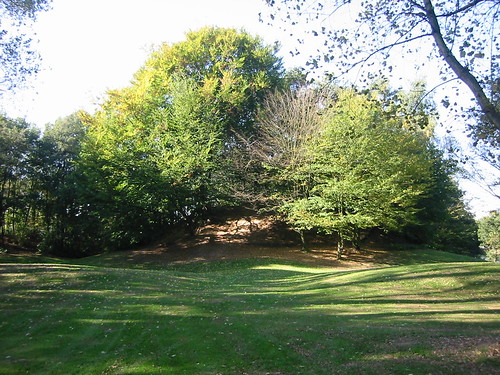Claude de Bigny, the blog's historical correspondent, who periodically posts on miscellaneous subjects here, has been visiting the old Wegberger Land (part of the Carolingian Mühlgau) in the Rhineland. He has been doing ancestral research in that quarter, and has discovered some little-known but interesting archeological sites, including a selection of mottes. He writes:
"The Ophover Motte is one of three mottes in Wegberg/Beeck, all of which were constructed in the late 10th/early 11th century. Unusually, all three have survived, albeit in a state not instantly identifiable as ancient fortifications. Whilst the other two are scarcely recognisable at all, being surrounded by thick woodland, the Ophover Motte is integrated into a public park - easily accessible and, with a little imagination, recognisable as a motte.
"It is highly probable this defensive network was commissioned by Gerhard (and/or his brother Rutger) d'Antoing von Wassenberg, whom the Saint-Emperor Henry II granted extensive lands in the Niederrhein between 1020 and 1024. In return for the grant of estates and lordships, the brothers were charged with keeping the peace in this anarchic area during a time of unrest.
"These holdings were originally centred around Wassenberg, and it is highly likely they also included the nearby "Wegberger Land".
"Whilst Gerhard's descendants became the Earls (later Dukes) of Gelre (Gelderland), Rutger's succeeded to the earldom (later dukedom) of Cleve. Wegberg remained part of the Gelre estates until recent times. The forests nearby were used as the earl's hunting grounds. And the river Schwalm, which was the old border between the dukedom of Gelre and the neighboring dukedom of Jülich, runs right through the centre of Wegberg.
"In line with this descendancy, it seems likeliest that Gerhard d'Antoing van Wassenberg was responsible for the three Wegberg mottes - this one, which is close by the old Ophoven mill, the one near the Beeck manor house, and the one in the woods between them - even though this isn't directly affirmed by contemporary documentation. What is certain is that he was responsible for appointing the motte at Wassenberg as his family's seat, and the place from which he took his original earldom.
"Further mottes in the area include the famous Alde Berg near Arsbeck (possibly also built by Gerhard d'Antoing van Wassenberg, although later associated with the Helpenstein family), which is the largest in the Niederrhein; the island-motte of Tüschenbroich; and numerous others, including an overgrown, scarcely identifiable motte north-east of Wegberg and another just south of Arsbeck.
"In all honesty, a taste for mottes is hardly widespread, but this landscape is profusely studded with their remains. They are agreeably low-key places - with nothing to identify them as historic monuments, aside from the atmosphere of abandoned timelessness which infuses them."
Claude de Bigny, October 2005.

No comments:
Post a Comment